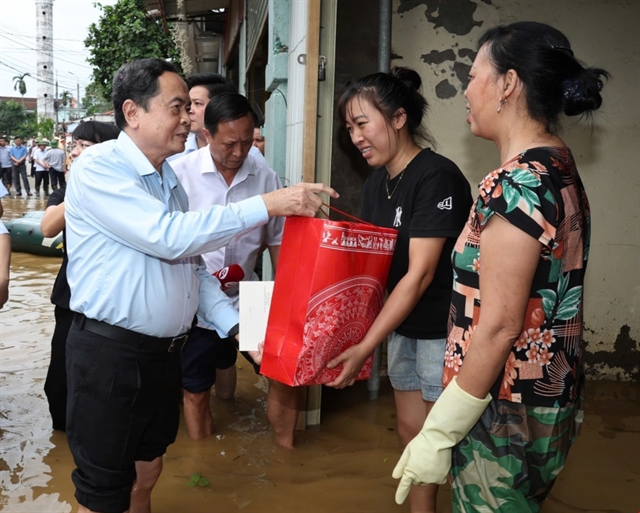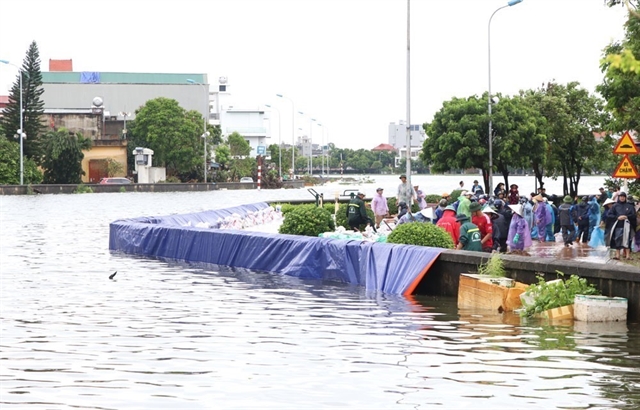 Politics & Law
Politics & Law

 |
| Local authorities and personel addressing the breaches on Bắc Hưng Hải irrigation system in the northern province of Hải Dương on September 12, amid severe flooding in the aftermath of typhoon Yagi. — VNA/VNS Photo Mạnh Minh |
HÀ NỘI — Prime Minister Phạm Minh Chính has ordered greater attention to the operation and regulation of the water levels at hydropower reservoirs in northern localities to ensure safety of the dyke systems and minimise damage due to floods in downstream areas.
In a dispatch sent to leaders of the Ministries of Agriculture and Rural Development, Industry and Trade, and Sơn La, Lai Châu, Hoà Bình, Điện Biên, Hà Giang, Lào Cai, Yên Bái, Cao Bằng, Bắc Kạn, Tuyên Quang, and Ninh Bình provinces as well as the Việt Nam Electricity, the PM noted that Typhoon Yagi, the third storm in the East Sea (internationally known as South China Sea) so far this year, carried torrential rains to the northern region, forcing many hydropower reservoirs in the northern midland and mountainous areas to urgently discharge water to ensure the safety of hydroelectric projects.
Currently, the water level downstream of rivers in the Red River - Thái Bình River basin is high, with above Level-3 alerts in some places, while some rivers are close to or have exceeded historical levels, threatening the safety of the dike systems, causing flooding in many residential areas, schools, medical facilities, and other essential infrastructure.
In order to minimise impact from flooding to people’s life and production and ensure utmost safety for reservoirs, the PM requested the Ministers of Agriculture and Rural Development, and Industry and Trade to coordinate with the chairpersons of the above-mentioned localities to direct the operators of reservoirs to regularly monitor the developments of rain and floods in the basin, focusing on operating and regulating reservoirs, flexibly cutting, reducing, and slowing down floods to the downstream, while ensuring safety for hydropower plants and strictly following the inter-reservoir operation procedure.
Reservoir operators must strictly follow reporting regulations, providing information to authorised agencies of localities, the Ministry of Agriculture and Rural Development and the Ministry of Industry and Trade to help them take timely response measures in emergency circumstances, the Government leader asked.
They were requested to closely cooperate with authorities in the downstream area of the dam and relevant agencies to strictly notify and warn local people of flood developments and flood control operations, enabling them to apply preventive measures.
PM Chính assigned Deputy PM Trần Hồng Hà to take the charge of directing ministries and localities to implement this dispatch.
On September 12, the National Centre for Hydro-Meteorological Forecasting said that water in many rivers, including Thao, Lô, Cầu, Lục Nam, Thái Bình, Hoàng Long and Hồng (Red) Rivers is receding.
However, the flood level in the Hồng-Thái Bình river system remains high, receding slowly, with a risk of flooding and other natural disasters.
According to experts, the process of flood easing in the Hồng River system is slow. Therefore, flooding in riverside areas in the coming days is likely to linger on in low-lying areas of Hà Nội, Bắc Giang, Thái Nguyên, Ninh Bình, Nam Định, Thái Bình, Hà Nam, and Hải Dương.
Prolonged high flood levels can cause risks of overflowing and landslides in riverside dykes in Hà Nội, Hà Nam, Nam Định, Hải Dương, Hưng Yên, Thái Bình, and Ninh Bình, while risks of flash floods and landslides remain in the mountainous areas of the north, they warned. — VNS




